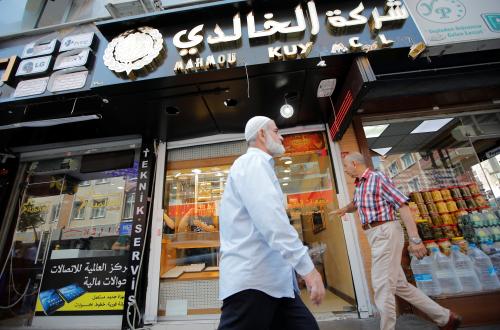Lebanon is on the brink of collapse. It has experienced a self-inflicted financial and economic meltdown, the pandemic, and the massive blast at the Port of Beirut. Saddled with a faltering confessional governance structure, unable to undertake reforms and unlock foreign assistance, sectarian and social tensions are rising as the economy spirals downward. GDP decreased 20.3 percent in 2020 and is projected to decline 9.5 percent in 2021.
With the Lebanese pound devalued by over 80 percent, inflation exceeding 140 percent, and 40 percent unemployment, “the middle class [is] becoming poor and the poverty of the extremely poor … might reach the point where they are unable to procure food.” The poverty rate is estimated to have doubled to over 55 percent between 2019 and 2020 while extreme poverty has tripled to 23 percent; 841,000 Lebanese are under the food poverty line.
In these indexes and others, Lebanon’s Syrian refugees are doing worse than their hosts. The United Nations High Commissioner for Refugees (UNHCR) reports that Lebanon has 865,530 registered Syrian refugees and estimates all Syrians in Lebanon at 1.5 million. Worldwide, Lebanon (population 6.8 million) is second only to the island of Aruba (population 110,000) and its displaced Venezuelans in the ratio of refugees to the native population.
Worldwide, Lebanon is second only to the island of Aruba in the ratio of refugees to the native population.
With overwhelmingly Sunni Syrians accounting for over 20 percent of Lebanon’s population, their presence was seen as threatening the country’s confessional governance and stability, eliciting immediate opposition from various groups. Lebanon’s fraught relationship with Syria over many decades has not helped and the crisis has worsened negative perceptions from accusations of stealing jobs from natives to crime. Yet, according to Stanford’s Immigration Policy Lab, few refugees want to go back. The fear of a Syria run by Assad and an economic crisis that rivals Lebanon’s trump any government moves to push them out by worsening their situation, even as calls for their return occasionally erupt into violence.
An estimated 90 percent of Syrian refugee households live in extreme poverty, up from 55 percent in early 2019. The U.N. says these households are living on less than half the Lebanese minimum wage, roughly $36 monthly and shrinking in real terms. This means deprivation of basic human needs, including food, safe drinking water, sanitation, health, shelter, and education. Indeed, over 80 percent of Syrian refugees lack legal residency since Lebanon stopped allowing UNHCR to register Syrians in 2015. To register outside UNHCR, a Lebanese sponsor, the approval of the authorities, and an annual $200 renewal fee are required. This is unaffordable for most and approvals are difficult. Thus, many cannot access services, are hampered in their movements, and are exposed to exploitation, detention, and deportation.
An estimated 90 percent of Syrian refugee households live in extreme poverty, up from 55 percent in early 2019.
In December 2020, 50 percent of Syrian households were suffering from food insecurity, a doubling since 2019. Damaging coping mechanisms such as reducing the number and portions of meals per day are increasing. Since 2019, food prices have gone up 402 percent. With the sharp drop in informal employment opportunities, refugees are also accumulating more debt—93 percent borrowed for food, 48 percent for rent, and 34 percent for medicine. Female-headed refugee households are more food insecure than male-headed households while more female-headed households (68 percent) use crisis-level coping measures than male-headed households (13 percent), including child marriages, withdrawing children from school, child labor, begging, etc.
Should Lebanon run out of funds for its subsidy scheme, the situation could deteriorate dramatically. Currently, the caretaker government is pruning its list of 300 basic food and household products while decreasing subsidies on gasoline. With foreign exchange reserves fast dwindling, how long the annual expenditure of $6 billion on subsidies can be kept up is unclear. Presumably, basic subsidies for wheat, medicines, and fuel for electricity will remain until the very last moment.
Even before the crisis, education was a challenge, with 58 percent of Syrian refugee children out of formal education in 2018. Many of those who were in formal education (190,000 in 2020-2021) attended afternoon classes in public schools, but now many Lebanese have moved their children to public schooling, limiting slots for refugee kids. Furthermore, distance learning plans have been delayed, and even when fully launched, the technology and costs will pose barriers. Save the Children says that thousands of children, Lebanese and refugees, “may never get back to school either because they have missed so much learning already or because their parents can’t afford to send them to school.” Worryingly, donor funding is decreasing.
The pandemic has exposed the vulnerabilities of the refugees’ precarious health situation. Syrian refugees face a death rate more than four times the national average. UNHCR pays 85 percent of primary health care costs for refugees. Support also comes from local and foreign NGOs, the World Bank, and others. Secondary and tertiary health care institutions are mostly private, and too expensive for most refugees. Though numbers are hard to come by, as of April 5, some 1,159 Syrians had been vaccinated (though 6,701 were eligible and total registrations were 17,891). There are serious issues around registration and access to information, with refugees fearing arrests, deportations, etc.
Already a trickle of Lebanese and Syrians have made their way to Cyprus. To avoid a crisis like in the Aegean and Mediterranean Seas in 2015-2016, the international community—and especially the European Union—needs to step up in a manner commensurate with the scale of the crisis. This increasingly dire humanitarian tragedy requires appropriate financial and other assistance to prevent a catastrophic breakdown in Lebanon and a displacement that could further destabilize Europe and beyond. For that, there are three preconditions that seem necessary.
- Funds need to be increased and provided directly to refugees, host communities, and supporting U.N. agencies. No one, least of all the Lebanese, trusts government processes and institutions. So largely nongovernmental mechanisms will be needed.
- Refugees should be provided an environment in terms of status, access to services, and livelihood opportunities commensurate with significantly larger amounts of funds coming in. The 2016 EU-Turkey agreement, which provided 6 billion euros to Turkey in two tranches, is a model worth looking into, especially as a new one is in the works. This time the program should precede and preempt, rather than come after a massive displacement crisis. Tailored to Lebanon, it would target refugees and the vulnerable, incorporating development aid in stages.
- Europe and the world have to turn another trickle, that of the resettlement of refugees in third countries, into a much more robust flow—something that largely failed in the Turkey-EU agreement. Ideally one would also see a much more sustained and focused effort on peace in Syria to create conditions for refugee returns, reconstruction, and the lifting of fear.
The Brookings Institution is committed to quality, independence, and impact.
We are supported by a diverse array of funders. In line with our values and policies, each Brookings publication represents the sole views of its author(s).









Commentary
Why Syrian refugees in Lebanon are a crisis within a crisis
April 15, 2021